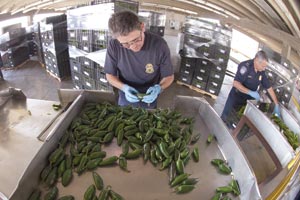Senior Reporter
USDA to Raise Inspection Fees 187% on Imports From Canada, Mexico

The U.S. Department of Agriculture last week issued a final rule designed to recoup costs associated with animal and plant inspections by raising fees for all truck-borne imports by 187%.
The final rule, effective Dec. 28, sets the fee for using truck transponders at $301.67, up from the current $105.
And, the one-time fee to cross the border into the United States from Canada or Mexico will increase to $7.55 from $5.25.
The final rule was a follow-up to a proposal issued by the USDA’s Animal and Plant Health Inspection Service, or APHIS, in April 2014. It said the most recent fee adjustment was in 2009.
“We have determined that revised user fee categories and revised user fees are necessary to recover the costs of the current level of activity, to account for actual increases in the cost of doing business and to more accurately align fees with the costs associated with each fee service,” APHIS said in the rule, published in the Federal Register on Oct. 29.
“Despite its higher cost, purchase of a transponder will still provide cost savings for most cross-border trucking firms — the average number of crossings per firm is 97 per year — and will also reduce their paperwork and wait times,” APHIS said.
In addition to the border inspection fee, U.S. Customs and Border Protection also charges a $100 annual truck inspection fee.
Boyd Stephenson, vice president of international supply chain operations for American Trucking Associations, was dissatisfied with the rule.
“It’s a terrible imposition, completely inappropriate,” Stephenson told Transport Topics. “We think that it’s a very, very, very bad idea.”
He acknowledges that APHIS should be allowed to recoup its border costs but said truckers, in effect, are being double-charged by both APHIS and Customs and Border Protection, whose agents actually conduct most of the border inspections.
“We don’t mind paying the cost for those front¬line inspectors,” Stephenson said.
However, ATA does maintain that it’s unfair to contribute to APHIS’ overhead, such as headquarters staff salaries, Stephenson said.
APHIS said it followed federal guidance related to fee setting and managerial cost accounting in determining costs for agricultural quarantine and inspection program.
The agricultural quarantine and inspection program is a federal effort designed to facilitate safe agricultural trade and to identify and address threats to U.S. agriculture, such as the accidental or intentional introduction of animal diseases and plant pests.
Direct animal agriculture hazards include foot-and-mouth disease, avian influenza and classical swine fever, APHIS said.
Plant pests include foreign noxious weeds such as hogweed, and insects such as long-horned beetles related to the Asian long-horned beetles that have caused millions of dollars in losses.
Fruit flies, such as the Mediterranean fruit fly, if introduced, would cause significant direct damage to U.S. fruit crops and have major effects on export markets, inspection officials said.
Likewise, diseases such as powdery mildews on corn, wheat blast on wheat and related grains and exotic rice diseases could cause major effects on staple food supplies and create trade barriers, according to APHIS.
The fees that pay for agricultural quarantine and inspection “help protect our country from these threats at a very small cost in relation to the economic harm that would be caused by any new introduction of pests and diseases,” APHIS said.
In 2014, comments on the proposed rule drew criticism from trucking companies and other industries, including maritime shipping, commercial cruise lines, airlines, producers of flowers, fruits, and vegetables and importers and shippers of those commodities.
Many of them called for greater transparency regarding the agency’s calculation and allocation of the proposed user-fee adjustments and new user fees.



